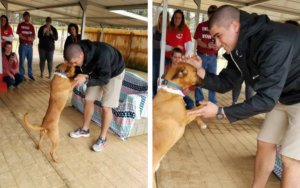A Guide To Cushing’s Disease In Dogs

Difficult to diagnose, Cushing’s disease is a condition affecting a dog’s endocrine system–the glands that produce and secrete hormones throughout the body. One of those hormones, cortisol, is responsible for stress management and balancing the immune system. Cortisol is essential for healthy body function, but too much or too little can cause problems. A dog dealing with increased levels of cortisol has hyperadrenocorticism—more commonly known as Cushing’s disease.

Causes
There are three types of Cushing’s disease in dogs. The most common is caused by a benign tumor on the pituitary gland located in the brain. This is called pituitary-dependent hyperdrenocorticism (PDH) and represents around 80 percent of all naturally occurring cases of Cushing’s disease. Rarely, pituitary tumors are malignant, which means they metastasize to other areas of the body.
The other form of naturally occurring Cushing’s disease is adrenal-dependent hyperadrenocorticism (AHD). The adrenal glands are found above the kidneys and secrete a variety of hormones. Tumor growth interferes with proper function and can cause increased levels of cortisol. Adrenal tumors have an equal chance of being either benign or malignant.
The third type of Cushing’s disease has nothing to do with tumors. It happens when medication a dog is already taking interferes with the endocrine system and leads to hyperadrenocorticism. Dogs taking regular medication to treat allergies, immune disorders, and cancer are most at risk. It even happens to dogs taking medication for low levels of naturally occurring cortisol. In these cases, the medication does its job too well and elevates cortisol production to dangerous levels.
Symptoms
There are several symptoms associated with Cushing’s disease, but the trick is most symptoms are also associated with other medical conditions. Not every dog with Cushing’s disease will exhibit all symptoms, and some side effects are mild enough to go unnoticed for several years. The disease most often affects adult dogs six years and older. Noticing symptoms in your dog isn’t enough to warrant a diagnosis, but it’s a place to start. Seeing two or more of these side effects in an adult or senior dog is an indication it’s time to talk to a vet.

1. Increased Hunger and Thirst: Some dogs are greedy eaters that act like they’re starving all the time, but a dog that doesn’t usually beg for food might start showing signs of increased hunger due to high cortisol levels. You could also find yourself filling up their water bowl more than normal to quench their considerable thirst.
2. Increased Urination: An adult dog that’s been house trained for years might start having regular accidents inside simply because they can’t get outside fast enough. They might also start waking up in the middle of the night to ask to go to the bathroom.
3. Pot-Bellied Abdomen: There are several reasons for the appearance of a pot-belly in dogs including roundworm infection, peritonitis, and bloat. When it’s Cushing’s disease, the dog’s fat migrates to the stomach, and they loose muscle tone. Their belly will look overly round and the rest of their body will look especially frail in comparison.
4. Loss of Hair: Hairloss will usually start in discreet areas like the armpits and belly. As symptoms progress and the disease worsens, bald areas will spread to the dog’s shoulders, back, and neck.
5. Increased Panting: Panting is something all dogs do, and it’s hard to tell when it’s related to a medical problem. If you’ve had your dog for several years, you should have a general idea of how much they pant. If they start panting on a regular basis for no apparent reason—like when they’re lounging on the couch or waiting for dinner—it could be Cushing’s disease.
Low energy, muscle weakness, darkening of the skin, recurring infections, and infertility are other less common symptoms that when put together point in the direction of Cushing’s disease.

Diagnosis
Spotting a few symptoms in your dog is enough to warrant a trip to the vet, but it isn’t enough for a diagnosis. Diagnosing Cushing’s disease requires a series of diagnostic tests. The first of these tests after a basic physical exam is usually a urine analysis to check the ratio between cortisol and creatinine. If cortisol levels come back high, it’s not a definitive answer the dog has Cushing’s disease. It means they might have it, but additional tests are needed to narrow down possible culprits.
A low-dose dexamethasone suppression test is usually next in the lineup. Depending on results, there might also be need for an ACTH stimulation test and an abdominal ultrasound. The barrage of tests means more time spent in the vet’s office, but there are several other conditions Cushing’s disease is easily confused with. In order to make an accurate diagnosis, veterinarians look at the dog’s health from all angles.
Treatment
Once an official diagnosis is made, the first thing dog owners ask for is a cure. Unfortunately, there is no effective cure for Cushing’s disease. The best chance of a cure happens with ADH, but most dogs (and their owners) learn to manage the disease for the rest of the pet’s life.

In mild cases, veterinarians usually suggest holding off on treatment until it’s absolutely necessary. A dog whose only symptoms include heavier than normal panting and minor hair loss on their stomach, for instance, isn’t having their day-to-day happiness affected by the disease. The drugs used to counteract hyperadrenocorticism have serious side effects, and it’s usually in the dog’s best interest to spare them that risk for as long as possible.
When the symptoms progress to threaten the dog’s emotional and physical well-being, the owner can talk to their vet about moving forward with treatment. Each type of the disease requires a specific treatment strategy.
For cases that develop due to medication, treatment is the simple process of slowly weaning the dog off the medication. Stopping all together can lead to the opposite problem of low cortisol levels (Addison’s disease). Weaning usually takes place over several weeks, and it’s important for the dog’s owner to carefully watch out for a sudden decline in health. Once successfully weaned off the medication, the dog will need a replacement treatment for the original condition.

Cushing’s disease related to a tumor in the pituitary gland is treated with one of two drugs. Lysodren and Vetoryl help counteract the problems caused by the tumor, but they also come with dangerous side effects. Persistent vomiting, diarrhea, depression, and lethargy are all possible. Dogs on these medications need to be regularly monitored to ensure the side effects don’t outweigh the benefits. The dog will most likely need to be on the medication for life.
For an adrenal tumor, treatment is usually more extensive, but there’s also a chance at a cure. There’s a higher risk of the tumor spreading to other parts of the body, and a CT scan or MRI is needed to rule this out. If the tumor spreads, it could affect the body in a number of ways depending on where it goes. If the tumor is ruled benign, the first step in treatment is usually a medication to shrink the tumor. The dog will be put on a strict medicinal schedule for several months as veterinarians plot the tumor’s size. When it’s an appropriate size, it’s usually suggested the dog have surgery to remove it. If all goes well and the tumor didn’t spread, this procedure is a dog’s best chance at a cure.
The prognosis for a dog with Cushing’s disease depends heavily on the dog’s age, overall health, and the seriousness of the disease. Most dogs live several years after being diagnosed, and treatment affects their quality of life only minimally. Proper veterinary intervention and persistence on the part of the dog’s owner usually leads to successful management of all symptoms. A positive diagnosis of Cushing’s disease shouldn’t be taken lightly, but early diagnosis and well-timed intervention gives your dog a good chance at a happy and healthy life.
via Whisker Therapy


















 Did you know that it is more difficult to get into vet school than it is to get into medical school, and the education often takes longer?
Did you know that it is more difficult to get into vet school than it is to get into medical school, and the education often takes longer?

















